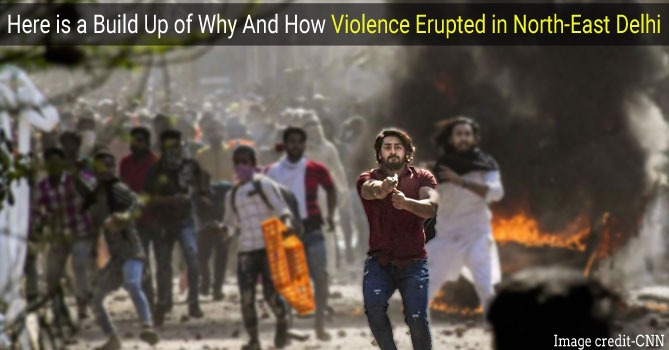
The Latest
Death toll in the Delhi violence touched the 43 till Friday. The Delhi Police has transferred the North East Delhi riots probe to the Crime Branch, and the cases will now be probed by two Special Investigation Teams (SITs).
A total of 148 FIRs have been registered and 630 people have been either arrested or detained so far in connection with the North East Delhi communal violence. Delhi Commission for Women has also announced an inquiry into the sexual crimes against women which might have taken place during the riots in Delhi’s North-East district earlier this week.
Why this happened
At the time of writing, the violence in North-East Delhi continues unabated despite the introduction of Section 144. But now, people have lost their lives and hundreds injured, several vehicles and shops burnt, including a petrol pump. Despite heavy police and paramilitary presence, the CAA violence that ensued because of the clash between anti CAA and pro CAA protesters continued on the second day. Among the dead was Delhi Police Constable Rattan Lal, a father of three. After imposing Section 144, National Security Advisor Ajit Doval visited some riot-hit areas.
Delhi Violence and clash of Anti CAA and Pro CAA protesters
The clashes erupted in three districts of northeast Delhi between supporters of the Citizenship (Amendment) Act (CAA) and those opposing it.
The question is, what triggered the violence and why now?
Who instigated the violence, especially when the capital was busy putting its best foot forward in welcoming the US President Donald Trump, on his first official visit to India after becoming President?
Let’s look at the genesis of the problem, which led to the government introducing the CAA and the subsequent opposition to it, and finally, the violence which followed.
The genesis of the problem
The root of the problem dates back to 1947 when the country partitioned along religious lines. The Muslims demanded and got Pakistan, but a sizeable Muslim population chose to remain in India while a far lesser number of Hindus decided to remain in Pakistan.
In the last 70 years, the Hindus, Sikhs, Christians, and Buddhists of Pakistan have been reduced to a single-digit percentage of the total population, while in India, the Muslim community has grown and relatively prospered.
In many districts in India, the demographic changes have resulted in the once-majority Hindus reduced to minority status, causing much resentment among all non-Muslim communities.
Assam, a border state with Bangladesh, emerged home to a steady flow of illegal Hindu and Muslim migration from erstwhile East Pakistan from 1951-1970. The brutal crackdown by the Pakistan Army in East Pakistan in 1971 led to the formation of Bangladesh and India faced a significant problem of over 10 million refugees, both Hindus and Muslims. Assam had to absorb the majority of the refugees, leading changes in the social demographics in the state.
Since 1971, the illegal migration from Bangladesh has continued and remains the root cause of anti-immigrant and anti-Muslim resentment across the country.
The Citizenship (Amendment) Act 2019 (CAA), National Register of Citizens (NRC), and National Population Register (NPR)
On 11 December 2019, the Parliament passed the Citizenship (Amendment) Act 2019 (CAA), allowing persecuted Hindu, Sikhs, Jains, Buddhists, Christians, and Parsis from Pakistan, Afghanistan, and Bangladesh citizens who entered India on or before 31 December 2014, to seek Indian citizenship.
The bill makes no mention of persecuted Muslims from Pakistan, Afghanistan, and Bangladesh, Rohingya Muslims from Myanmar, Tamil refugees from Sri Lanka, refugees from Nepal, Bhutan, or Tibet, leading to the series of protests witnessed across the country.
The National Register of Citizens (NRC) came into existence through the 2003 Amendment to the Citizenship Act 1955. The NRC was first implemented in 2013-14 in Assam to identify and deport illegal residents. It has led to resentment among locals and tribes of the north-east, many of whom do not have papers to prove their ancestry.
The JNU, Jamia, and Aligarh Muslim University protests
The sequence of events points to a coordinated response of protests across the country which leads to the conclusion; the protests have morphed from genuine concerns voiced by a section of Muslims and non-Muslims, into one which has become entirely Muslim and has led to polarization between those who support CAA and those who oppose it.
Both sides have political support, which is adding to the tensions.
14 December 2019
Protests began in Assam and Delhi, with some areas of the former turning violent. In South Delhi, a small group of protestors started a sit-in in Shaheen Bagh.
15 December 2019
Protests by Jamia University turned violent in Jamia Nagar in South Delhi, leading to the police lathi charging the protestors and following them into the campus.
Similar protests and clashes took place on the Aligarh Muslim University campus.
Across India, anti-CAA protests broke out, leading to police lathi charging protestors in several places.
16 December 2019
Students of Nadwa College clashed with the police when they tried to take out a protest march.
5 January 2020
60-100 masked goons entered the JNU campus in Delhi and beat up students protesting against the CAA. The resulting violence led to further protests across the country in support of students of JNU. The protests in JNU started against the fee-hike but soon overlapped with the anti-CAA protest, leading to much anger among many outsides of the university.
By now, nationwide, tempers began rising with opinion divided in favour and against CAA.
The Shaheen Bagh Protest
A small sit-in peaceful protest, which began on 14 December, soon snowballed into a major protest, with thousands joining and blocking the connecting road between Noida and Mathura Road.
With massive television coverage, Shaheen Bagh became the face of defiance against the CAA with Muslim women leading the protest. In the initial days, they received a lot of emotional support from all parts of the country but the blocking of roads added to the misery of daily commuters. With political parties joining the fray, the Shaheen Bagh protest began evoking resentment among those in support of CAA.
Polarizing impact on the country
The problem of illegal immigrants is felt the most in metros and other major cities where many have sought shelter. Over the years, they have occupied unauthorized spaces with certain sections taking to illegal activities to survive, giving way to anger against their existence.
The CAA seemed a solution to many who want them out of their city, but governments don’t have an answer to where to put them or how to deport them since a large number have been born in India, and have acquired some form of identity documentation.
The government’s role or lack of it
The central government faulted in reading the potential of Shaheen Bagh to become a symbol of resistance against the government diktat. The central government did not attempt to engage, explain, or pacify the protestors in the early stages of protest, hoping it would lose steam over time. What happened was precisely the opposite.
Several opposition parties, including the Congress, SP, NCP, and the Left collectively spotted an opportunity to win brownie points against the government while hoping to win back Muslim support.
With each passing day, the resistance against CAA grew along with those supporting it.
The violence in North-East Delhi
On 24 February, all eyes were on the high profile visit of US President Donald Trump with PM Modi personally leading the hospitality extended to the visiting entourage.
This is where it gets murky.
What caused the violence to erupt during such a crucial time when there was no provocation or announcement from the central or state government of Delhi in connection with the CAA?
There is a strong suspicion the violence in north-east Delhi was planned and coordinated to coincide with the arrival of the US President. The ensuing spectacle to give India a bad name.
With all security focused on the US presidential tour, the security establishment was caught lacking. The resulting violence claimed several lives, further fanning communal hatred.
What started as a protest against a controversial bill has now become a Muslim versus non-Muslim agitation, the consequences of which will play out in the coming time.





